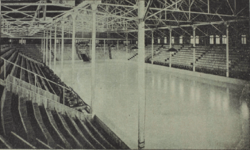
The Montreal Wanderers were an amateur, and later professional, ice hockey team based in Montreal. The team played in the Federal Amateur Hockey League (FAHL), the Eastern Canada Amateur Hockey Association (ECAHA), the National Hockey Association (NHA) and briefly the National Hockey League (NHL). The Wanderers were four-time Stanley Cup winners. Prior to the formation of the NHL, the "Redbands" were one of the most successful teams in hockey.
The National Hockey Association (NHA), initially the National Hockey Association of Canada Limited, was a professional ice hockey organization with teams in Ontario and Quebec, Canada. It is the direct predecessor of today's National Hockey League (NHL), and much of the business processes of the NHL today are based on the NHA. Founded in 1909 by Ambrose O'Brien, the NHA introduced 'six-man hockey' by removing the 'rover' position in 1911. During its lifetime, the league coped with competition for players with the rival Pacific Coast Hockey Association (PCHA), the enlistment of players for World War I and disagreements between owners. The disagreements between owners came to a head in 1917, when the NHA suspended operations in order to get rid of an unwanted owner, Eddie Livingstone.
The 1917–18 NHL season was the first season of the National Hockey League (NHL) professional ice hockey league. The league was formed after the suspension of the National Hockey Association (NHA). Play was held in two halves, December 19 to February 4, and February 6 to March 6. The Canadiens won the first half, and Toronto the second half. The season was contested by four teams, down from six in the previous season, finishing with only three, in Montreal, Ottawa and Toronto. The Montreal Wanderers withdrew early in January 1918 after their rink, the Westmount Arena, burned down. Toronto won the NHL playoff and then won the Stanley Cup, by defeating the PCHA's Vancouver Millionaires three games to two in a best-of-five series.
The 1918–19 NHL season was the second season of the National Hockey League (NHL). While at first it was uncertain that the NHL would operate, and the possibility that National Hockey Association (NHA) would be resumed, the unfinished business of Eddie Livingstone's Toronto and Ottawa's NHA franchise, led to the NHL owners suspending the NHA again. Livingstone would attempt to overthrow the NHA management, and failing that, attempt to operate a rival league. The pre-season was filled with legal actions, deceptions and public verbal attacks. Ultimately, the NHL operated with three teams, in Montreal, Ottawa and Toronto. However, the season ended early with Toronto suspending operations, leaving Montreal and Ottawa to play off for the championship. Montreal would win the playoff and travel to Seattle for the Stanley Cup Finals. However, the championship series was not completed due to influenza infecting the whole Montreal team and causing the eventual death of Montreal's Joe Hall.

Mutual Street Arena, initially called Arena Gardens or just the Arena, was an ice hockey arena and sports and entertainment venue in Toronto, Ontario, Canada. From 1912 until 1931, with the opening of Maple Leaf Gardens, it was the premier site of ice hockey in Toronto, being home to teams from the National Hockey Association (NHA), the National Hockey League (NHL), the Ontario Hockey Association (OHA) and the International Hockey League (IHL). It was the first home of the Toronto Maple Leafs, who played at the arena under various names for their first 13½ seasons. The Arena Gardens was the third rink in Canada to feature a mechanically frozen or 'artificial' ice surface, and for eleven years was the only such facility in eastern Canada. In 1923, it was the site of the first radio broadcast of an ice hockey game, the first radio broadcast of an NHL game, and the first broadcast of an ice hockey game by long-time broadcaster Foster Hewitt.
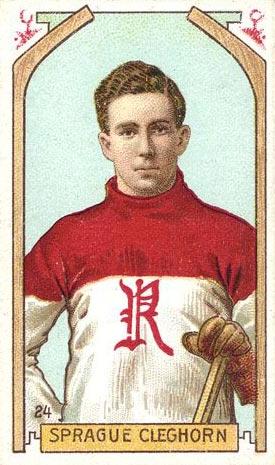
Henry William Sprague "Peg" Cleghorn, also known as "The Big Train", was a Canadian professional ice hockey player from Westmount, Quebec who played 17 professional seasons between 1911 and 1929 for the Renfrew Creamery Kings and Montreal Wanderers in the National Hockey Association (NHA) and the Ottawa Senators, Montreal Canadiens and Boston Bruins in the National Hockey League (NHL). He was a member of three Stanley Cup championship teams, winning with the Senators in 1920 and 1921 as well as with the Canadiens in 1924. His brother Odie was also a professional player and the two played several seasons together.

The Mount Royal Arena was an indoor arena located in Montreal, Quebec, Canada at the corner of Mount Royal and St. Urbain Street. It was home of the National Hockey League (NHL) Montreal Canadiens from 1920 to 1926, before moving to the then two-year-old Montreal Forum. It had a capacity of 6,000 seated, 10,000 when including standing room. It was a natural ice rink, without machines to freeze the ice mechanically.
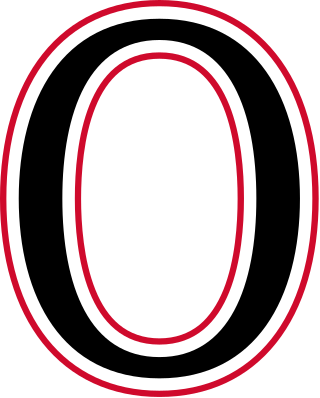
The Ottawa Senators were an ice hockey team based in Ottawa, which existed from 1883 to 1954. The club was the first hockey club in Ontario, a founding member of the National Hockey League (NHL) and played in the NHL from 1917 until 1934. The club, which was officially the Ottawa Hockey Club, was known by several nicknames, including the Generals in the 1890s, the Silver Seven from 1903 to 1907 and the Senators dating from 1908.
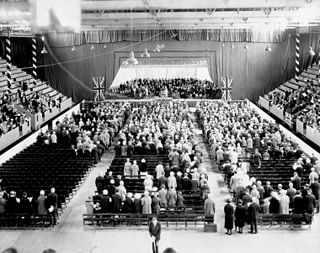
The Ottawa Auditorium was a 7,500-seat arena located in Ottawa, Ontario. It was located in Downtown Ottawa at the corner of O'Connor and Argyle Streets, today the site of the Taggart Family YMCA. Built primarily for ice hockey, the arena was also used for sports events, assemblies and musical concerts.
Dey's Arena, also known as Dey Brothers Rink, Dey's Skating Rink and The Arena, were a series of ice rinks and arenas located in Ottawa, Ontario, that hold importance in the early development of the organized sport of ice hockey in Canada. It was the home arena of the Ottawa Hockey Club, variously known as the Generals, the Silver Seven and the Senators from the 1890s until 1923, although it is known that games were also played at the Rideau Skating Rink in the 1890s and the Aberdeen Pavilion in 1904. The rink and arenas were built by two generations of the Dey family, who were prominent in Ottawa at the time, with a thriving boat works business serving the lumber business. The Dey family also played hockey.
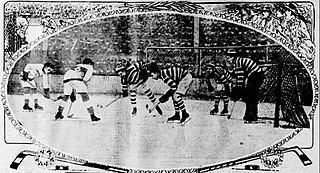
The 1912–13 NHA season was the fourth season of the National Hockey Association (NHA). Six teams played 20 games each. The Quebec Bulldogs won the league championship to retain the Stanley Cup. They played and defeated the Sydney Millionaires in a challenge after the regular season.

David Alexander Ritchie was a Canadian professional ice hockey player who played nine seasons in the National Hockey Association (NHA) and the National Hockey League (NHL) for the Quebec Bulldogs, Montreal Wanderers, Ottawa Senators, Toronto Arenas and Montreal Canadiens. He scored the first goal in NHL history, on December 19, 1917, as a member of the Wanderers in a game against the Toronto Arenas.
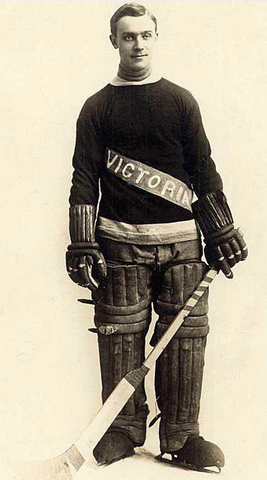
Leslie Bertrand Lindsay was a Canadian professional ice hockey goaltender in the National Hockey Association (NHA), Pacific Coast Hockey Association (PCHA), and National Hockey League (NHL). Born in West Garafraxa, Ontario, Bert Lindsay was the father of Hockey Hall of Fame player Ted Lindsay.

Patrick John McDonald was a Canadian professional ice hockey player who played from 1905 until 1922, including eleven seasons in the National Hockey Association/National Hockey League for the Montreal Canadiens, Montreal Wanderers, Quebec Bulldogs, Toronto Ontarios and Toronto St. Patricks. He was a member of the 1912 Quebec Bulldogs Stanley Cup championship team, playing eleven seasons for the Bulldogs in the period from 1905–06 until 1919–20.

James Cooper Smeaton was a Canadian professional ice hockey player, referee and head coach. He served referee-in-chief of the National Hockey League (NHL) from 1917 until 1937. Smeaton served as a Stanley Cup trustee from 1946 until his death in 1978. He was inducted into the Hockey Hall of Fame in 1961.
The 1917–18 Ottawa Senators season was the team's first season in the newly formed National Hockey League (NHL) and 33rd season of play overall. The Senators, along with the Montreal and Quebec franchises of the National Hockey Association (NHA), voted to suspend the NHA and form the NHL. Ottawa would finish second and third in the first and second halves of the season, and did not qualify for the playoffs.
In Ottawa, Canada, ice hockey clubs date back to the first decade of recorded organized ice hockey play. The men's senior-level Ottawa Hockey Club is known to have played in a Canadian championship in 1884. Today, Ottawa hockey clubs are represented in all age brackets, in both men's and women's, in amateur and professional.

The National Hockey League (NHL) was founded in 1917 following the demise of its predecessor league, the National Hockey Association (NHA). In an effort to remove Eddie Livingstone as owner of the Toronto Blueshirts, a majority of the NHA franchises suspended the NHA and formed the new NHL. The Quebec Bulldogs, while a member, did not operate in the NHL for the first two years. Instead the owners of the Toronto Arena Gardens operated a new Toronto franchise. While the NHL was intended as a temporary measure, the continuing dispute with Livingstone led to the four NHA owners meeting and making the suspension of the NHA permanent one year later.
The 1917–18 Montreal Canadiens season was the team's ninth season and first as a member of the new National Hockey League (NHL). The Canadiens sided with other members of the National Hockey Association (NHA) and voted to suspend the NHA and start the NHL to expel the Toronto Blueshirts ownership. The Canadiens qualified for the playoffs by winning the first half of the season, but lost the playoff to the temporary Toronto franchise, made up of Blueshirts players.
The 1917–18 Montreal Wanderers season was the 15th and final season of play of the Montreal Wanderers ice hockey club. Along with the Canadiens, Ottawa and Quebec, the club voted to suspend the National Hockey Association (NHA) and form the National Hockey League (NHL) to freeze out the Toronto NHA franchise owner. On the ice club still had difficulties fielding a competitive club, and when the Montreal Arena burned down, owner Sam Lichtenhein elected to suspend the club. The team is officially credited with having played six games, though they only actually played the first four; the other two were declared forfeit.
